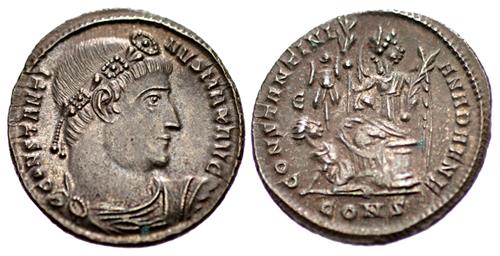
|
Constantine I. AD 307/310-337. Æ Follis (19mm, 2.71 g, 11h). Dafne coinage. Constantinople mint, 5th officina. 3rd emission, AD 328-329.
Electronic Auction 470
Lot: 413. Estimated: $ 75
Roman Imperial, Bronze
Sold For $ 375. This amount does not include the buyer’s fee.
Go to Live
|
|
Constantine I. AD 307/310-337. Æ Follis (19mm, 2.71 g, 11h). Dafne coinage. Constantinople mint, 5th officina. 3rd emission, AD 328-329. CONSTANTI NVS MAX AVG, laurel and rosette-diademed, draped, and cuirassed bust right / CONSTANTINI ANA DAFNE, Victory seated left on cippus, head right, holding branch in each hand; to left, bound captive seated left, head right, at base of trophy; Є|–//CONS. RIC VII 35; Speck and Huston Third Issue, 8. Toned silvering, traces of deposits. Near EF.
Ex Giovanni Dattari Collection of Late Roman Bronzes.
McGregor (SAN 1984) in his article Constantiniana Dafne–a different point of view, is quoted by Speck and Huston in their study of this coinage Constantine’s Dafne Coinage at Constantinople, p. 2 “McGregor set out the religious significance of this reverse type–portraying Constantine as Dafne, turning away from the symbols of the pagan religion (Apollo and Sol) toward the palm, symbol of Christianity. It is the first obviously Christian coinage design ever issued at a Roman mint. Its significance at this mint at this time can hardly be misinterpreted–Constantine is announcing to his new city that it is to be a Christian city. The message is local and specific, and it is the only message he presents on the coinage during the entire period of its construction as the new Christian capitol.”
Giovanni Dattari, an Italian businessman born in the mid-1850s, moved to Cairo, Egypt 30 years later and became fascinated with the Roman provincial coinage of Alexandria. His vast and comprehensive collection of Roman Egyptian coinage was first published in 1901 and still serves a primary reference for the series. Dattari also collected other coin types as well, including nearly 20,000 Roman Imperial coins of Alexandria and other mints, with the same eye for quality and variety that he devoted to the provincial coinage, although he did not employ the same intensive cataloguing and record keeping. His collections were dispersed in large group lots in the early 1900s, several of which remained intact until they were acquired by two European dealers in recent years and were sold in a series of auctions. This offering of Late Roman bronzes formed part of one such intact lot and will be offered in this and subsequent CNG electronic auctions both as single and small group lots.
Closing Date and Time: 17 June 2020 at 12:17:20 ET.
All winning bids are subject to an 18% buyer’s fee.
|
